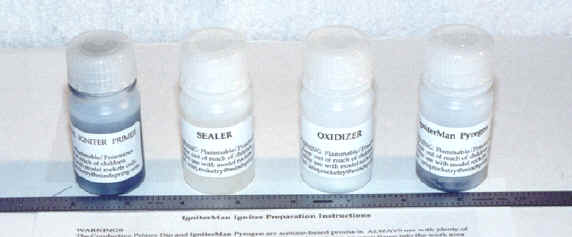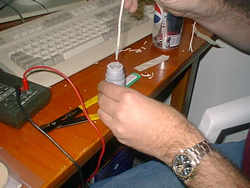 LUNAR’clips
LUNAR’clips
Livermore Unit of the National Association of Rocketry July/Aug 2002
Copyright © 2002 by LUNAR, All rights reserved.
Igniting a Large BP Cluster
Advice was requested on igniting a large BP cluster, for a rocket using 8 carefully selected Estes igniters. The idea of using 16 alligator clips was not appealing, and even if the igniter leads on adjacent motors are twisted together, that would still be 8 sets of leads to deal with.
The first suggestion was to build a custom ignition harness for this job, soldering 8 igniters together with only 2 leads for the alligator clips, giving fewer connections and fewer spots to get shorts.
The use of alternative igniters was suggested, with options including rolling your own, buying a bunch of nichrome igniters, or useing a FireStar igniter. The latter was acknowledged as being an expensive solution, however. For rolled nichrome, FireStar Pyrogen, or the Igniter Man stuff, was suggested; just dip up a bunch of home brews, make a "clip whip" setup and push the button.

Estes igniters are ok for single motors, but for clusters, especially big clusters, a hot, reliable igniter is a must. Sounds like homemade ignitors are the way to go then. More reliable and longer leads. Small ignitors can be made using #28 wirewrap wire and Rob's secret sauce (Igniterman kit).
When building a custom ignition harness, parallel was suggested as being better than serial ignition, but perhaps a network configuration would be the best. For 8 igniters, maybe a 2x4 network. But if you're using a simple clip whip, it's all parallel pretty much. It kind of depends upon how much space there is between motors as well. If you can't get a simple Estes igniter lead to reach over to the next one, then you suddenly have options to consider. If you're making your own, use 28 gauge wire wrap wire, or 24 gauge red/white bell wire with nichrome ends, and make them long enough to reach. Twist all the white ones together, and all the red ones together. It's a parallel hook-up. Or, to make the network, twist two whites together and two reds together, and daisy chain them. You'll have four sets of parallels in series. This will help keep the overall resistance lower than having all eight in series and possibly not firing. One thing to note, however, is that they should all be really close to the same resistance value or you run the risk of popping one first (the one with the lowest resistance value) and leaving the rest high and dry. That's why I think that plain ol' parallel is best. If the launcher can push the juice, it will work the best.

As for metallic vs. plain BP. No real need to use a metallic pyrogen, but it always burns hotter, and if there's a little clay blocking the nozzle, it will probably not be a problem. You get a lot of "burn for your buck", and with a big cluster, why chance it? Pyrogen is cheap (if you have it already - or if you can bum some!) compared to the possible failure and embarrassment!
The reference to "pyrogen" is talking about the compound from the Igniterman kit, which is normally used as a second coat over the black "conductive primer" when making igniters for composite motors. For BP motors, the Igniterman instructions say that you can make igniters using just the black primer, but a light coat of the gray pyrogen (evidently some sort of powdered metal/oxidizer/lacquer mixture) will get things going all the more vigorously .
As for firing several Igniterman dips in parallel, the LUNAR high power system should handle it... when you make them, check the resistance of each igniter after it dries and pick out matched sets.
I'm sure the LCO at any LUNAR launch would be willing to pop a "test fire" for you if requested. (For safety, it might be best to do this when there were no rockets hooked up on the other pads of that set, avoiding any risk that might arise from the fact that you would be out at the pad area watching the igniters when the system was armed to fire them...)

A couple of other suggestions... use 2 different colors for the wire, to save confusion when connecting the igniters together - you can then connect all the red (for example) wires together, and all of the blue wires together, knowing that there's no way you could accidentally connect both wires of any of the igniters to the same terminal. Also, it's probably a good idea to leave a long-ish tail on each igniter (perhaps a couple of feet) so that if first motion does occur before the last igniter fires, it has a moment or two to get going before the wires pull out.
Lee Teicheira’s check list looks like:
All content is the responsibility of LUNAR.
If you have comments or suggestions regarding these web pages,
please contact the 
Copyright © 1992 - 2025 LUNAR